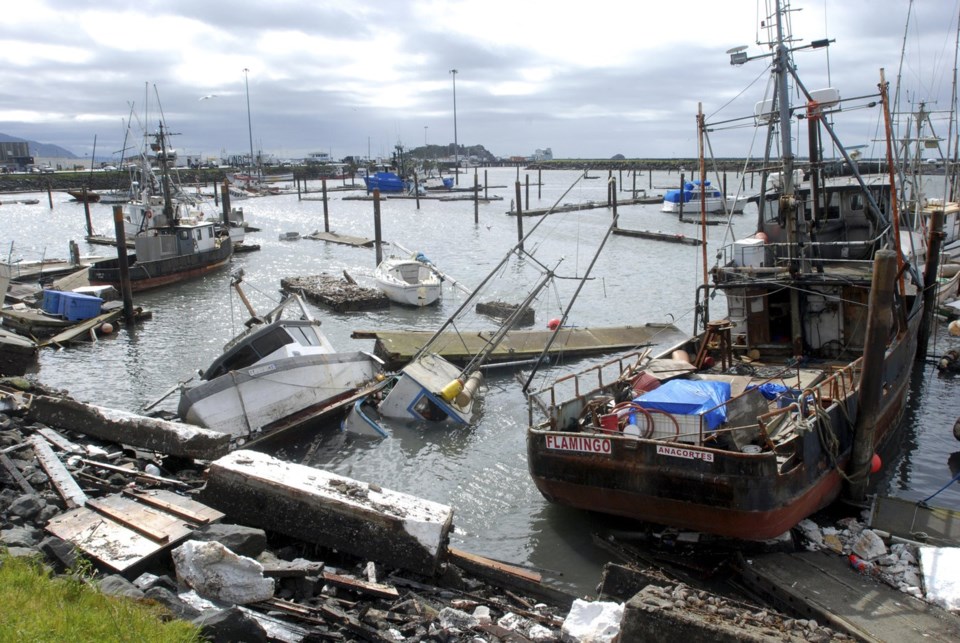SAN FRANCISCO (AP) — A small California coastal city near the border with Oregon that has recorded dozens of tsunamis, including one that killed 11 people more than 60 years ago, saw little damage Wednesday as locals returned to their routines amid sunny skies in the town known as a tsunami magnet.
Crescent City recorded waves of up to 4 feet (1.22 meters) early Wednesday — the highest recorded anywhere in the continental United States following an 8.8-magnitude earthquake centered off the coast of Russia's Far East hours earlier. Still, those were far smaller than the 21-foot (6.40 meters) waves caused by the deadly 1964 tsunami.
This time, no one was injured in the city of 6,600 and there was no major flooding, with downtown open later Wednesday morning. A dock at the city’s harbor was damaged, and officials warned people to stay away from beaches and waterways.
“A lot of people who aren’t from here did evacuate. But they ended up coming right back because nothing happened,” said Rose Renee, who works at Oceanfront Lodge that looks out at the famed Battery Point Lighthouse.
A surge of water lifted the dock off its pilings around 2:40 a.m., eventually submerging it, Harbormaster Mike Rademaker said at a news briefing. The dock was engineered to disrupt the waves' force before they reach the inner harbor and appears to have functioned as intended, he said.
City has been tsunami magnet for centuries
Crescent City is highly susceptible to tsunamis because of an underwater ridge, just offshore, known as the Mendocino Fracture Zone. The ridge funnels tsunamis into deeper water where they pick up speed before they hit the town. Forty-one tsunamis have been observed or recorded since the first tide gauge was installed in Crescent City in 1933.
The oral history of local native peoples, geologic evidence and the written records of people elsewhere in the Pacific Rim suggest that tsunamis have battered this shoreline for centuries, according to city records.
The 1964 event, considered the worst tsunami disaster recorded in the United States, began with a 9.2 magnitude earthquake in Alaska, according to the Crescent City website. Three small waves caused little damage, but then a big wave — nearly 21 feet (6.40 meters) — devastated 29 city blocks.
The quake caused 15 deaths, and the ensuing tsunami caused 124 deaths: 106 in Alaska, 13 in California and 5 in Oregon, according to the National Oceanic and Atmospheric Administration’s National Centers for Environmental Information.
Crescent City rebuilt downtown, and today a walking tour highlights high-water marks posted on surviving buildings, objects pushed by waves and memorials to those who died.
A tsunami caused by the March 2011 earthquake in Japan killed one person in Crescent City and damaged the harbor.
Max Blair, a volunteer at the Del Norte Historical Society, which manages the town's museum and historic lighthouse, said locals have tsunami drills at least once a year. When there is danger of one, cellphone notifications go out and the tsunami sirens in the town sound warnings. Resident then turn to KCRE radio for information, Blair said.
If ordered to evacuate, people move to higher ground, normally the town's Walmart about 2 miles (3.22 kilometers) from the shore.
“We evacuate if it's forecast to be a big wave. But the first wave was coming in at low tide and it was only a couple feet, so we just have to stay away from the beach,” Blair said.
The city’s website warns that a tsunami could happen anytime. Since most of downtown is in the tsunami run-up zone, if there were a near-shore earthquake, people would only have minutes to reach safety. Thirty-two tsunamis have been observed in the city since 1933, including five that caused damage.
It is still not safe to head to the beach
The greatest impact from the tsunami event along the coast Wednesday morning was around Crescent City with strong tidal swings, including up to 4-foot waves, according to James White, a meteorologist at the National Weather Service’s Eureka office.
Officials stressed that conditions may be improving, but it wasn't yet safe to head to the beach on Wednesday. There were still dramatic tide fluctuations that must carry high currents, the city manager said.
“It seems like whenever we have these events, it’s also time that we lose someone just because they’re in the wrong place and they get caught off-guard, and then they’re swept out,” Weir said.
___
Brumfield reported from Cockeysville, Maryland.
Olga R. Rodriguez And Sarah Brumfield, The Associated Press




